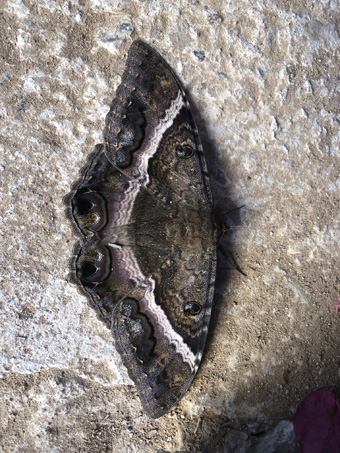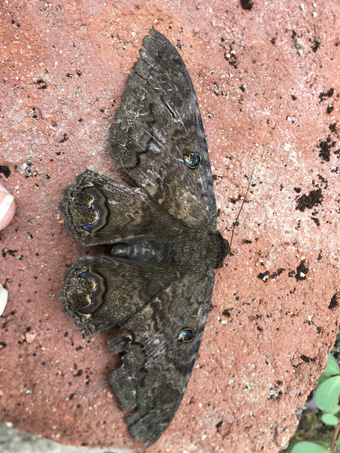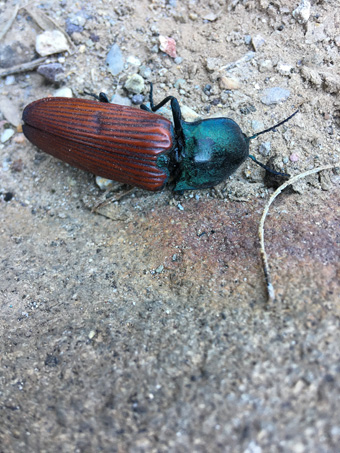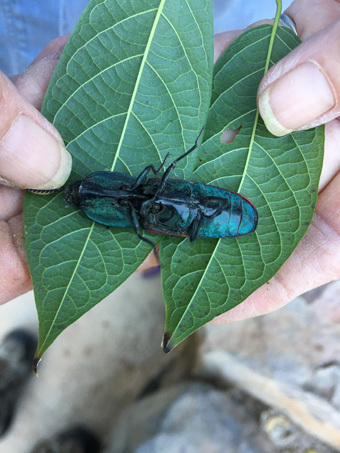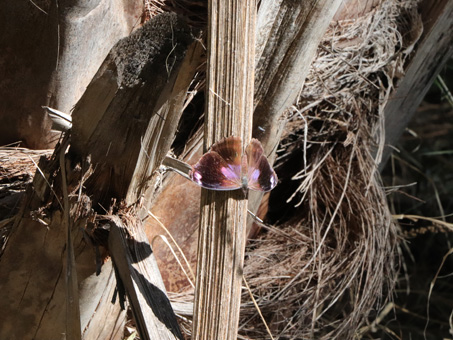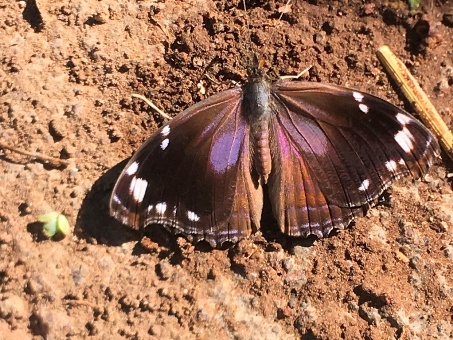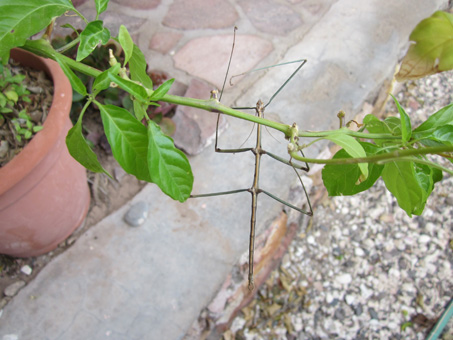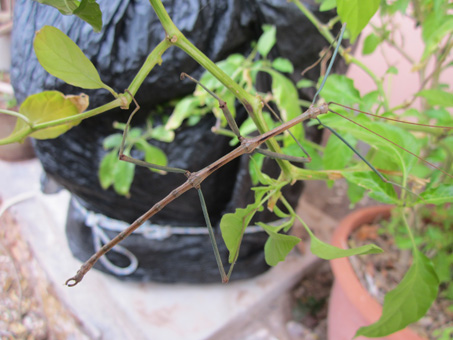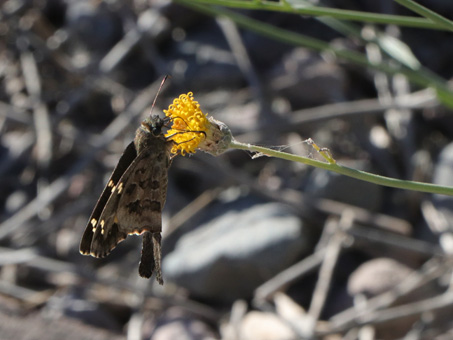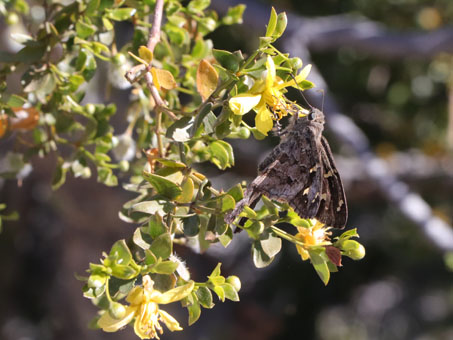THE UC HIVE AUG 2023
In the Aftermath of Hurricane Kay — Part 2
Guerrero Negro to Palo Verde — Nov 8, 2022
We pick up the trail from last month´s entry in Guerrero Negro and head south to Mulegé and whatever surprises waiting for us there at home in la huerta.
Some of the worst highway damage we encountered had occurred both about 15 miles south of Guerrero Negro near Ejido Benito Juárez and about 15 miles north of San Ignacio.
We encountered three major detours where roadwork was underway and the going was very slow with semi-trailers stirring up the fine silt in the arroyo crossing making visibility difficult.
In this image (right), taken around Ejido Benito Juárez, there is now a very wide arroyo where last spring there was just a narrow dry river bed. The cement slabs used to be a part of the road crossing the wash.

One 10 minute detour was so washboarded that, as I let off on the brake and reached a speedy 2 mph, our trailer would start to bounce wildly side-to-side opposite to the car. Here is one of the nice, smooth detours...
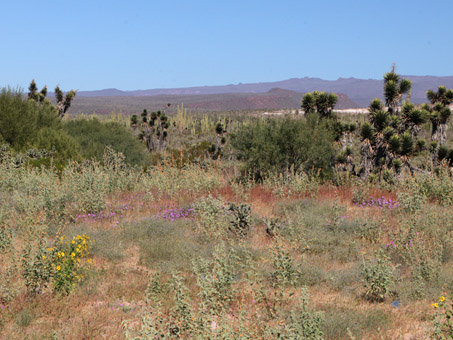
One of my favorite spots on Hwy 1 at the turnoff to Sierra San Francisco. This year there was dense growth & many flowers.
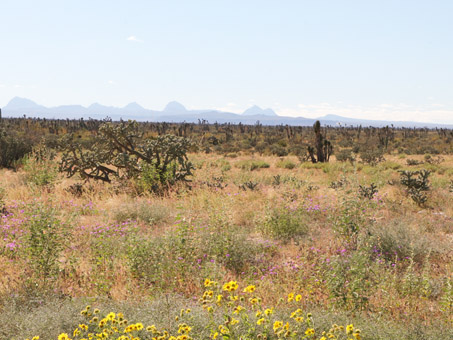
Looking west across the Vizcaíno Desert, with the Sierra Santa Clara right near the Pacific coast off in the distance.
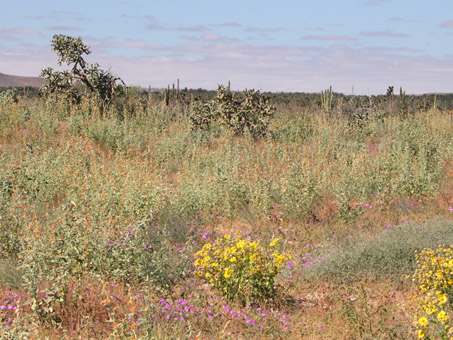
Apricot Globemallow (Sphaeralcea ambigua), Slender Sand Verbena (Abronia gracilis) & Crownbeard (Verbesina encelioides).
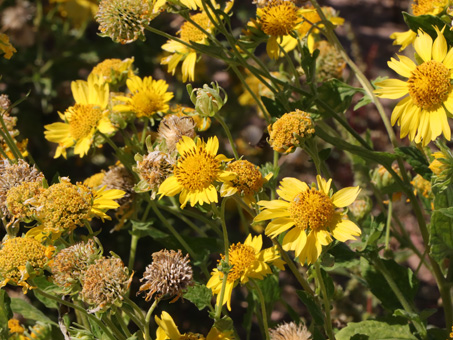
Crownbeard (Verbesina encelioides). These naturalized annuals were abundant and full of bees and butterflies.
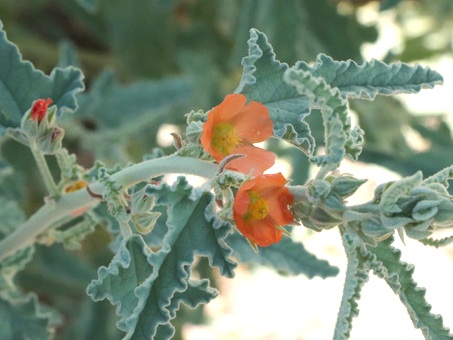
Apricot Globemallow produces prolific amounts of fruit and does very well in disturbed areas.
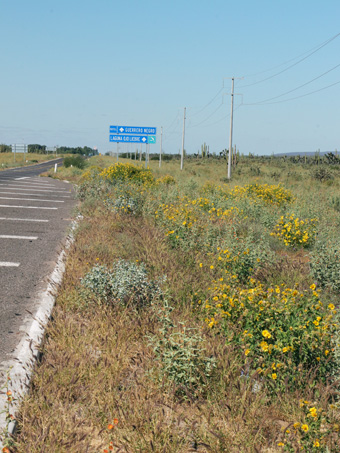
Last March, this stretch was covered with very tall Apricot Globemallow {Sphaeralcea ambigua) as far as the eye could see down the highway (see image).

Slender Sand Verbena (Abronia gracilis, Nyctaginaceae) could be seen between the larger, more robust growth.
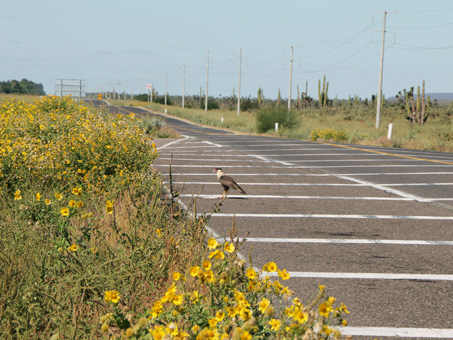
Right after we'd parked, I was surprised to see this Caracara (Caracara plancus) land close behind our vehicle and walk over to check out some plastic roadkill.
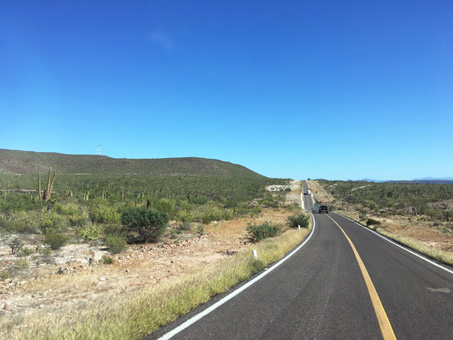
Km 90 N of San Ignacio: the vegetation was very green on this long bajada, but there were few visible flowers.
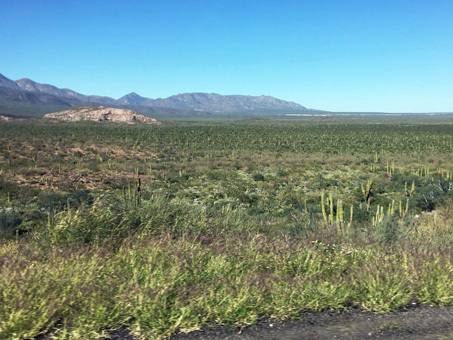
The desert valley as we descended the low grade near Volcán Tres Vírgenes. There are large swaths of Creosote (Larrea tridentata) & Cholla (Cylindropuntia cholla) on the valley floor. In March 2022, it was much drier and the parched Creosote gave it an olive-green cast.

Descending into a side canyon feeding into the main arroyo just N of Santa Rosalía. The hills were the greenest I remember seeing them since maybe 2015 after Hurricane Odile.
Palo Verde to Mulegé — Nov 8
Highway bridge washout at Boca de Magdalena near Palo Verde. With the newer construction methods, generally just the earthen connectors at each end of the bridge get washed away, instead of the span of the bridge. The bridge was back up and functional within just a few days and the final repairs would be complete in a few months.
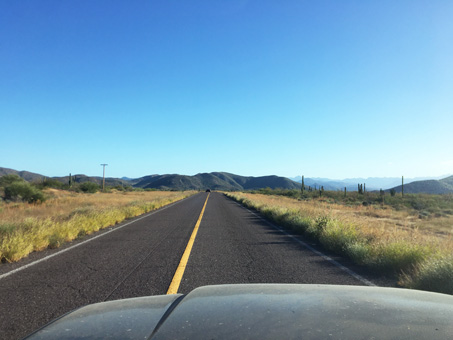
On the homeward stretch not far north of Mulegé's Las Plumas grade.
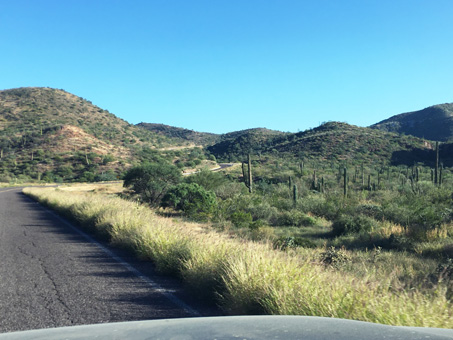
Km 142, just before Las Plumas grade. All the green made me happy.
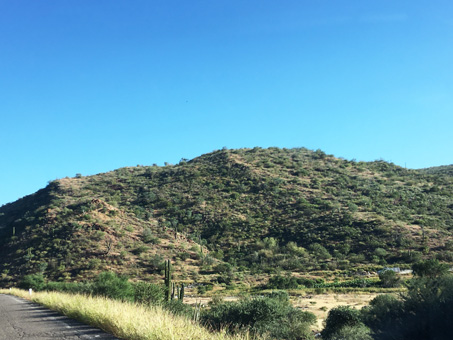
Top of the grade at Las Plumas, near the garbage dump.
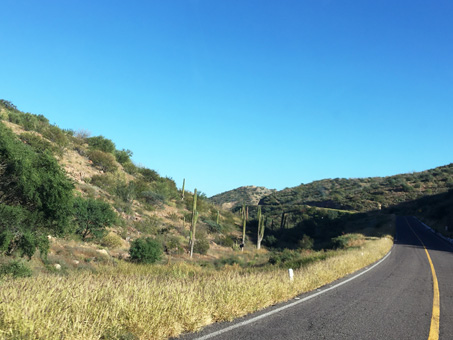
Just about to start the descent to our home away from home.
In Our Backyard — Nov 8 - 30
Our place was totally overgrown after all the late summer rain. Not just the garden plants and trees, but the "weeds". I am an equal opportunity botanist/naturalist so pretty much any plant or organism is worth investigating, be it weed, pest or endemic.
It didn´t take me long to get out into the garden and orchard by our place to see what interesting things there might be. On our first day, just moving our stuff from the car to the house along the garden path, several things caught my eye. There were lots of butterflies and other insects flitting around. There were also a number of plants new to the garden, some local natives and some not. That first day, I found two species that I´d not yet documented in my inventory of the Mulegé area.
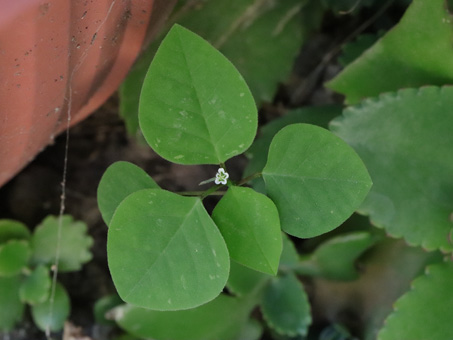
For some unfathomable reason this small annual is known as Grassleaf Spurge (Euphorbia graminea), I had seen it limping along in the yard back in late spring and had collected it a few years back, but it was now popping out of cracks and crevices all over the garden.

The larger, mostly leggy plants of E. graminea were about 30-40 cm H. The broad ovate leaves are 1-4 cm L x W. The cyathia are terminal, c. 3 mm D. The five glands are green with whitish, petaloid appendages <1 mm L.
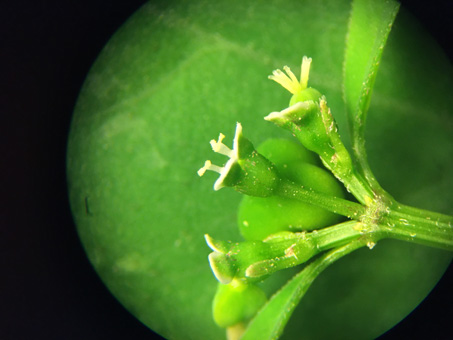
Side view of the cyathia and the enlarging 3-lobed fruits of E. graminea. From above, the outline of each lobe is ovate. The capsule is wider than high: 2.5-3 mm H x 3-3.5 mm D. This euphorb doesn´t exude latex.
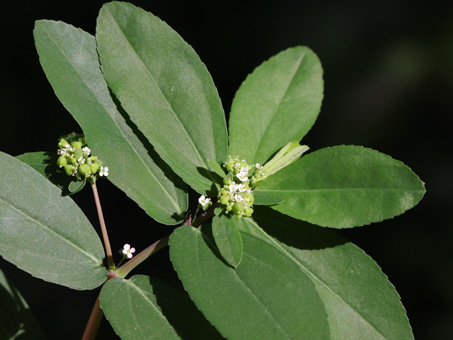
Another prolific garden "weed". I've seen Graceful Sandmat (Euphorbia hypericifolia) only once before, south of La Paz, so this is a new record for my area. The plants were c. 40-50 cm L, with gracefully decumbent stems. It is an attractive addition to the garden.
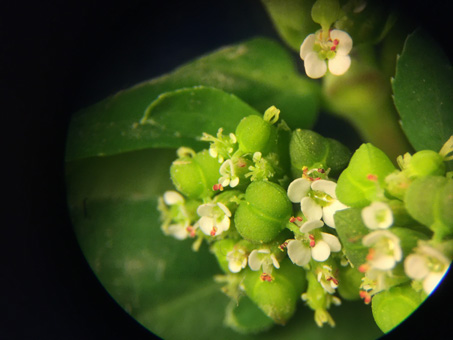
Unlike in E. graminea, the flowers are born in dense axillary or terminal capitate glomerules. Each cyathium has 4 tiny greenish glands with whitish appendages <<1 mm L. The fruit is 3 lobed, <1.5 mm L X D, its apex depressed.
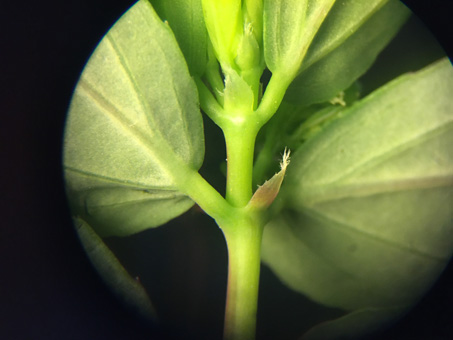
Underside of E. hypericifolia leaf showing a deltate stipule, lacinate-fringed at the tip. The leaf margins are shallowly toothed. This can be seen in the photo on the left in the top right corner as well as the first photo of the species above.

I had noticed the long, strappy leaves of this lily-like plant in the orchard last spring but paid no further attention to it. Soon after our return, the large, bizarre flowers caught my eye. In the genus Hymenocallis (Amaryllidaceae), it is native to the southern US and South America.

The common names include Basketflower & Spider Lily. The scapose inflorescense has several large flowers with a central cup c. 3-4 cm D created by the fusion of the bases of the stamens, and 6 narrow, spreading tepals c. 8-10 cm L. Quite the exotic plant that enjoys the damp soil near a leaky faucet.
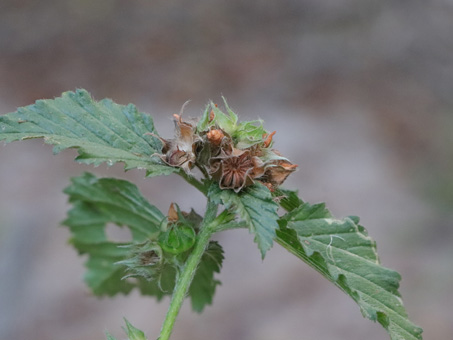
Our Common Mallow is living up to its reputation as a wide-spread weed. I first saw a few plants of this species in 2001 nearby, but until this past spring when we moved into our new place, I hadn't seen it again. It has become very much a perennial ground-cover in the garden, with the hundreds of small plants, each about 30-40 cm H, growing close together. We´ve managed to trample the ones in the way so that we now have a nice pathway through them. They can be quite attractive with little specks of yellow in a field of green.
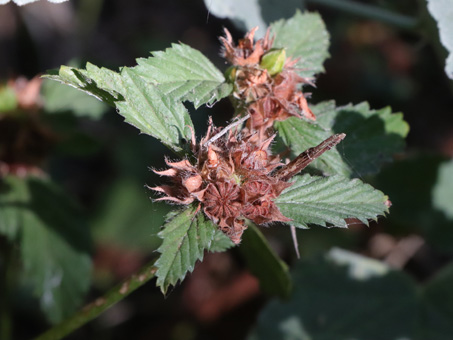
The flowers of Common Mallow are often congested at the tips of the stems. Here, the flattened, 5-6 mm D, wheel-like fruits (schizocarps) are an attractive reddish brown. Each schizocarp will break up into 10-12 segments (mericarps).
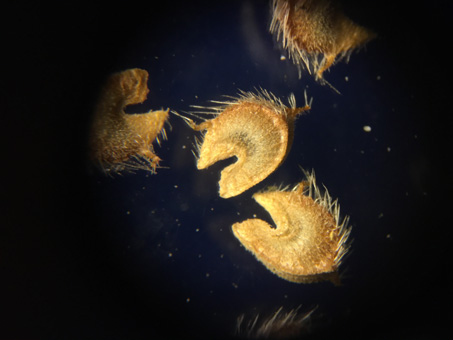
Mericarps of Common Mallow at 20X. The distinctive, papery mericarp is c. 3-4 mm L x D, and actually has 3 apical cusps (one hardly visible in this 2D view), as well as a couple of awns. Each mericarp has one kidney-shaped seed.
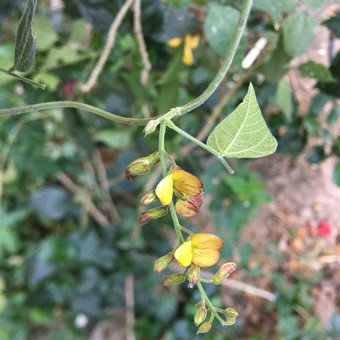
Rosary Snoutbean / Ojo de Perico. (Rhynchosia precatoria, Fabaceae). This species is native from Mexico to Colombia. Flowers are about 1 cm L, the banner tinted with reddish brown.
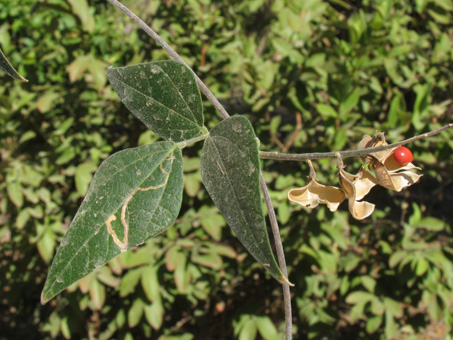
The fruit of Rosary Snoutbean is a small beanpod 2.5-3.5 cm L that is constricted between the 1-2 seeds. The seed is bright red and hard.
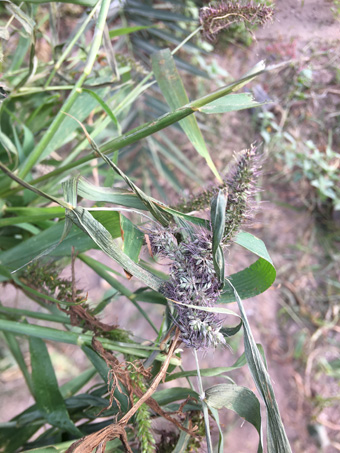
Adherent/Bur Bristlegrass / Cola de Zorra Pegajosa (Setaria adhaerens). This incredibly obnoxious grass is so well-adapted to grab on, that it even sticks to itself.
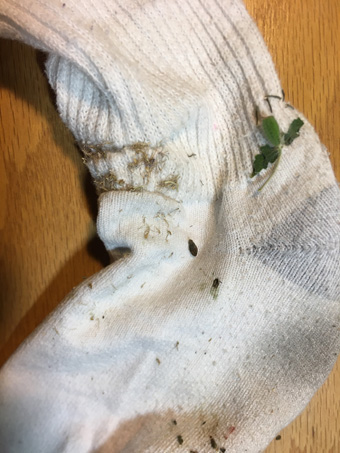
Socks with a variety of hitchhikers: Bur bristlegrass (top L), Pegarropa (Mentzelia adhaerens, top R), above that, five narrow black achenes of Amauria brandegeeana, and some Boerhavia xantii fruits (small & club-shaped, center and at bottom).
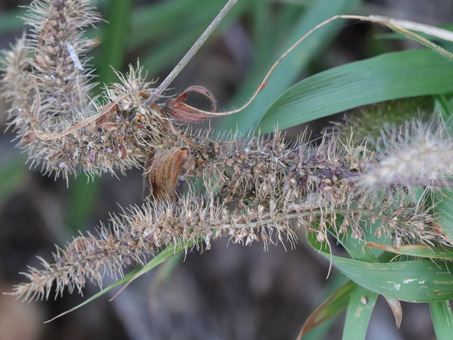
This Setaria wrecked many a pair of socks. The bristles lock into cloth fibers, essentially turning the fabric into velcro and sticking it to itself. Look closely at the socks above for the line that looks stitched together.
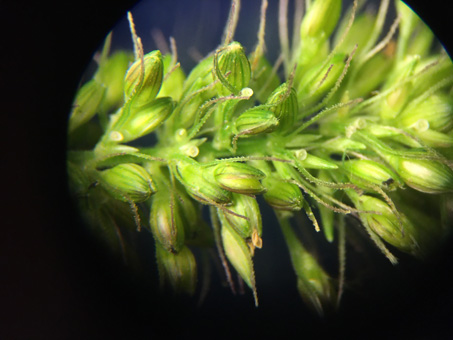
Closeup (20X) of the inflorescences. Spikelets are solitary or in groups, each subtended by a barbellate bristle. I gave up trying to remove the barbs from my socks, even with magnification, and just tossed them.
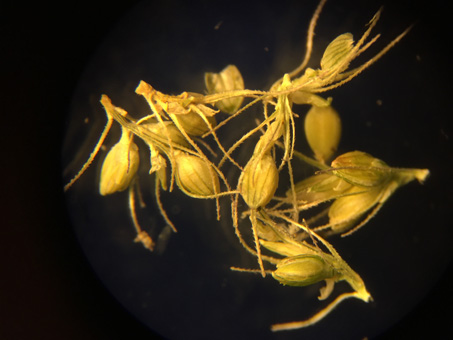
Spikelets of Setaria adhaerens (20X) showing the single bristle below each. The bristles remain attached to the axis once the spikelets fall.

Short branch of the inflorescence with a few spikelets of Setaria adhaerens still attached and a free caryopsis (grain) top left (20X).
Black Witch Moth / Polilla Bruja (Ascalapha odorata). These are very large, with a wingspan up to 17 cm W. The live moth on the left moth was resting on the patio around dusk. It has one wing pattern we saw. On the right is a dead moth with a different pattern. The large "eyespots" are purplish. There have been a number of these beauties, some of them fluttering against the window in the night.
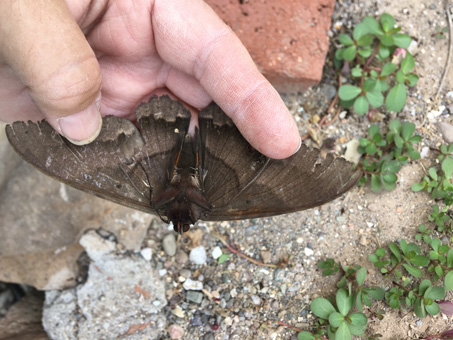
Underside of the Black Witch (Ascalapha odorata). Unfortunately, this second moth was dead, but gave me a chance to get a good look at it.

The body & legs of the Black Witch have very dense, long reddish brown/chocolate hairs.

Wait a minute! That´s not a moth beating on the window...it's a stray cat (Felis catus) that showed up soon after we arrived. Mr Meowgi has since moved in...
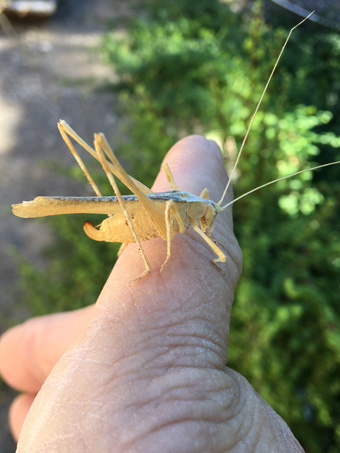
Katydid (species undetermined). This is the first time I've ever seen one. It was moseying along on the ground between bushes and climbed right up on my thumb. The antennae are incredibly long, as are the legs.
Ruby Click Beetle (Chalcolepidius rubripennis), an elater (in the family Elateridae). 4-5 cm L. Unfortunately this specimen was recently dead. The head is metallic blue-green and the elytra is wine-red or orange. The underside of all the body segments are metallic blue-green. They are called "Click" beetles because, if stuck on its back, it is able to bend its hingelike connection between segments and snap back, flinging itself through the air with a loud click. Now you know!

Texan Crescentspot / Mariposa Lunita Tejana (Anthanassa texana). There have been many of these small, dark brown, fast-moving butterflies in the garden & out in the desert as well. Wingspan: 38-42 mm. Larvae feed on plants in Ruellia & Justicia. Adults feed on flower nectar. They are widespread from Guatemala northward to southern California & the southern US in dDeserts, dry gulches, streamsides, open areas.
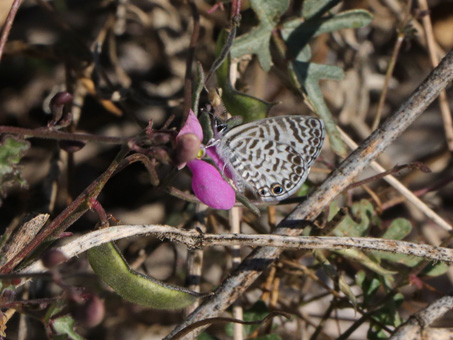
Cassius or Tropical Striped Blue / Mariposa Blanquiazul de Baja California (Leptotes cassius subsp. surbaja). Apparently the species is cold intolerant and is found mainly in the southern US (FL, TX), Mexico, the Caribbean, and C. & S. America. This subspecies is endemic to Baja California Sur. So far, it's been my first & only sighting. Wingspan 20-35 mm. The larvae feed on a number of species, including Phaseolus. Here, the is adult sipping on a Slimjim Bean flower (Phaseolus filiformis).
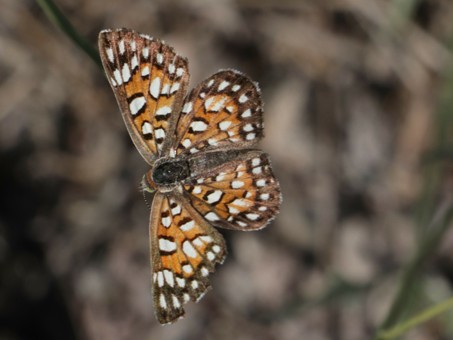
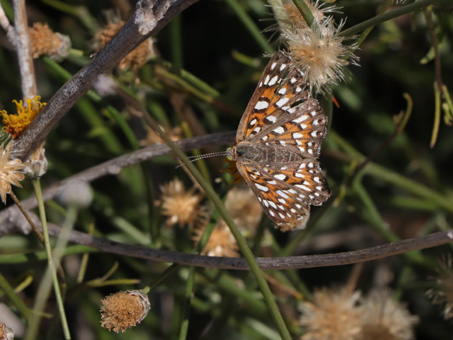
Baja California Metalmark / Mariposa Jaspeada Mexicana de Baja California (Apodemia mejicanus subsp. maximus). Wingspan 22-33 mm. There were numerous individuals and they were not disturbed by me trying to get a closeup photo. Many other species are very vigilant and the slightest movement will send them flying away. Adults feed on a variety of flowers, especially those of buckwheats & yellow-flowered composites. It is resting on Bebbia juncea, a yellow comp. Larval food: buckwheats (Eriogonum inflatum is in our area) and possibly Krameria (2 spp. are in our area, with plants near this photo location).
Blackened Bluewing / Mariposa Bufón de Alas Azules de Baja (Myscelia cyananthe ssp.streckeri). These beautiful dark brown, black, white & purple butterflies have been flitting around our yard all month. Wingspan: 50-55 mm. They seem to spend a lot of time on the ground, slowly opening & closing their wings. Adult food includes rotting fruit.

So many organisms are endemic to the peninsula, even the paperwasps! Baja California Paperwasp (Polistes lineonotus). And like so many wasps, they can be nasty if disturbed near their nests. But when hanging out on plants or feeding on the nectar feeder, they behave quite politely, and will fly off after a sharp tap on the feeder.
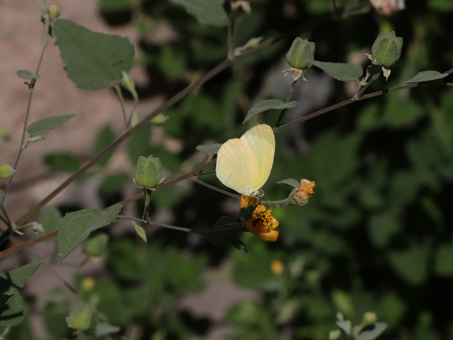
Mimosa Yellow / Mariposa Amarilla Mimosa de Borde Grueso Mexicana (Pyrisitia nise ssp. nelphe). Adults feed on flower néctar and larvae on Mimosa, and possibly Lysiloma (L. candidum present here). 29-51 mm wingspan.
A Walking Stick or Stick Insect (Diapheromera kevani). These slow-moving giants are well camouflaged. I only saw this one (8-10 cm L) because it was lying on the porch. I put it into a potted plant and it seems to have walked away eventually. There were several more over the next few weeks, , all of them missing at least one limb. Sadly, they didn't survive.
Long-tailed Skipper / Saltarina de Cola Larga Común (Urbanus [Thorybes] dorantes). Wingspan: 37-51 mm. Here feeding on Bebbia juncea. The Long-Tailed Skipper is fast & has be hard to photograph because it flits quickly between plants until it finally one it wants, where it then may hang out for a bit. Here on Creosotebush (Larrea tridentata).
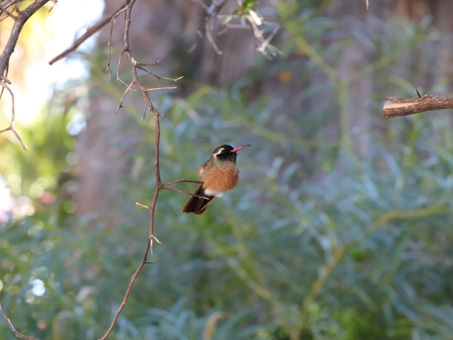
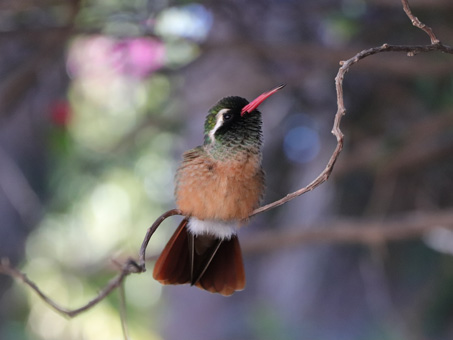
Our endemic, resident male Xantus Hummingbird / Zafiro de Xantus (Basilinna xantusii) loves to perch on this particular twig where he will whistle & chitter away. Puffed up like this, he measures c. 5 cm H. Full length, with tail & beak, he is c. 8-9 cm L. One day, I was about a meter and a half from his twig with the camera in hand when he landed on an even closer twig, practically in my face, & proceeded to let loose with his song, ignoring both me & the camera.
Despite their often charming behavior, both male & female Xantus' can be fiercly territorial. The species is one of only six birds endemic to the peninsula and is restricted to the southern state (BCS). In riparian areas, it is very common. The eye stripe on the dark face, red beak, buff belly and tail feathers
that flash a deep chestnut make for easy identification of the males. Our only other regular local hummingbird species is the Costa's Hummingbird. It is primarily found in desert scrub but also visits riparian areas and gardens.
That's it for this month. I've been busy since we arrived and have already made several field trips. So in upcoming installments*, I hope to share what I've found. Until then, hasta luego...
Debra Valov—Curatorial Volunteer
* Author's note: I originally wrote this entry for the January 2023 Beehive. But due to staffing changes at the Garden, the publication of the monthly newsletter was temporarily suspended. This entry was edited in July2023.
References and Resources
Flora of North America Vol 12. Euphorbiaceae. Euphorbia graminea: http://www.efloras.org/florataxon.aspx?flora_id=1&taxon_id=250016249, accessed 24 March 2023.
Flora of North America Vol 12. Euphorbiaceae. Euphorbia hypericifolia: http://www.efloras.org/florataxon.aspx?flora_id=1&taxon_id=242321438, accessed 24 March 2023.
Lotts, Kelly and Thomas Naberhaus, coordinators. [2023]. Butterflies and Moths of North America. Anthanassa texana. Accessed 2022-12-26 at https://www.butterfliesandmoths.org/species/Anthanassa-texana
Lotts, Kelly and Thomas Naberhaus, coordinators. [2023]. Butterflies and Moths of North America. Apodemia mejicanus. Accessed 2022-12-25 at https://www.butterfliesandmoths.org/species/Apodemia-mejicanus
Lotts, Kelly and Thomas Naberhaus, coordinators. [2023]. Butterflies and Moths of North America. Leptotes cassius. Accessed 2022-12-23 at https://www.butterfliesandmoths.org/species/Leptotes-cassius
Lotts, Kelly and Thomas Naberhaus, coordinators. [2023]. Butterflies and Moths of North America. Urbanus dorantes. Accessed 2022-12-25 at https://www.butterfliesandmoths.org/species/Urbanus-dorantes
Rebman, J. P., J. Gibson, and K. Rich, 2016. Annotated checklist of the vascular plants of Baja California, Mexico. Proceedings of the San Diego Society of Natural History, No. 45, 15 November 2016. San Diego Natural History Museum, San Diego, CA. Full text available online.
Rebman, J. P and Roberts, N. C. (2012). Baja California Plant Field Guide. San Diego, CA: Sunbelt Publications. Descriptions and distribution.
Valov, D. (2020). An Annotated Checklist of the Vascular Plants of Mulegé, Baja California, Mexico. Madroño 67(3), 115-160, (23 December 2020). https://doi.org/10.3120/0024-9637-67.3.115
Wiggins, I. L. (1980). The Flora of Baja California. Stanford University Press. Keys and descriptions.
Zacharias, E. H. (2013) Atriplex polycarpa, in Jepson Flora Project (eds.) Jepson eFlora, Revision 1,
https://ucjeps.berkeley.edu/eflora/eflora_display.php?tid=15258, accessed on December 17, 2022.









































